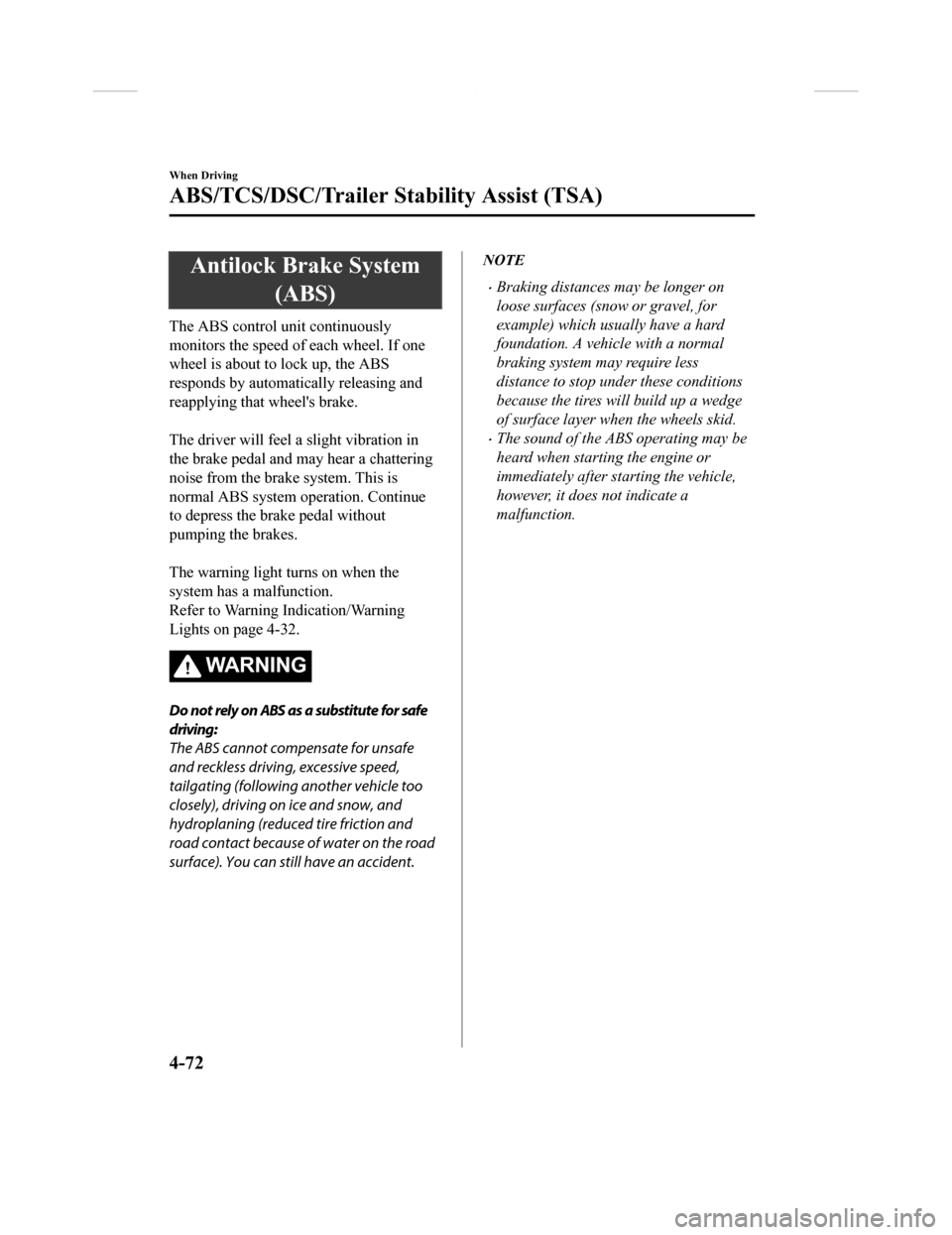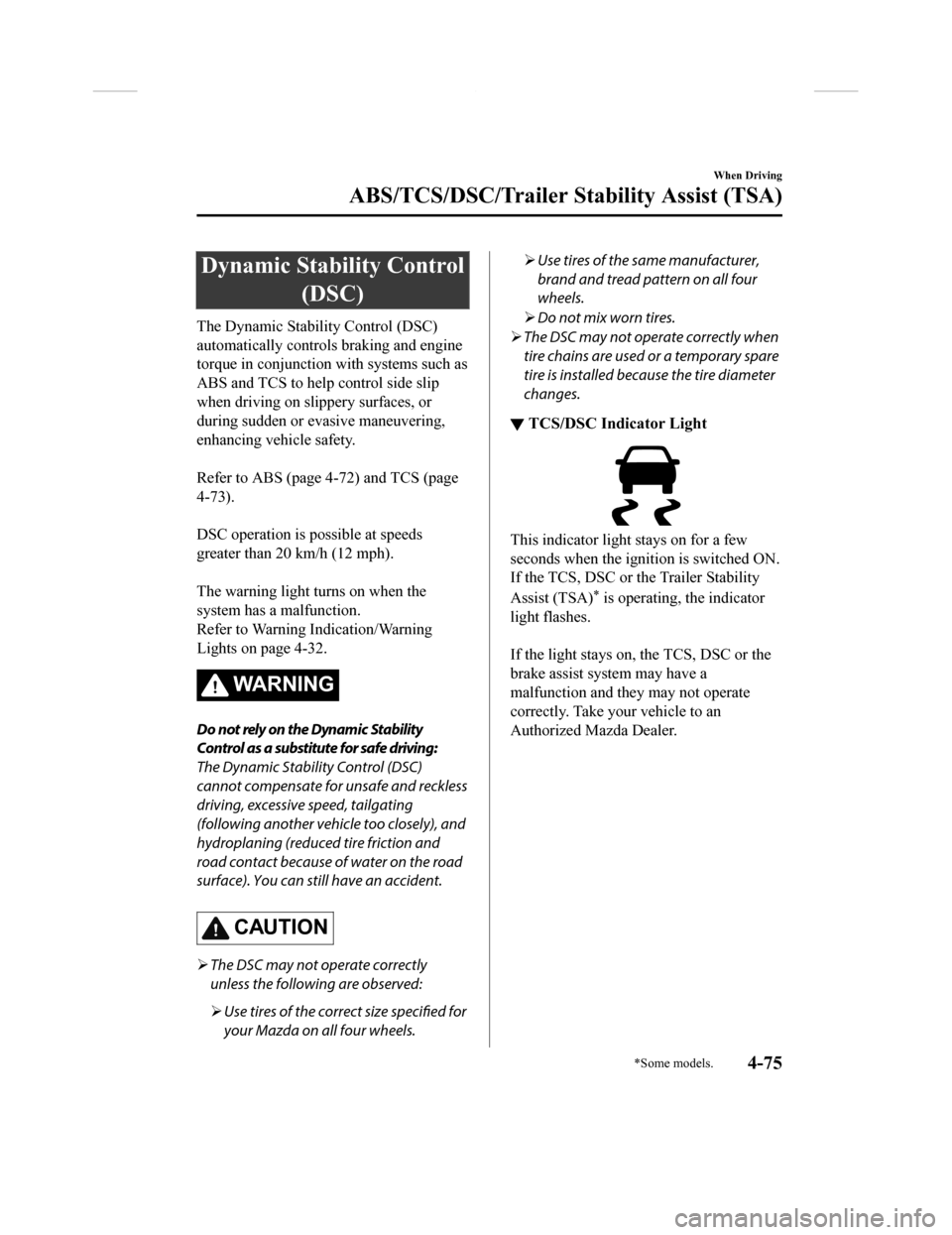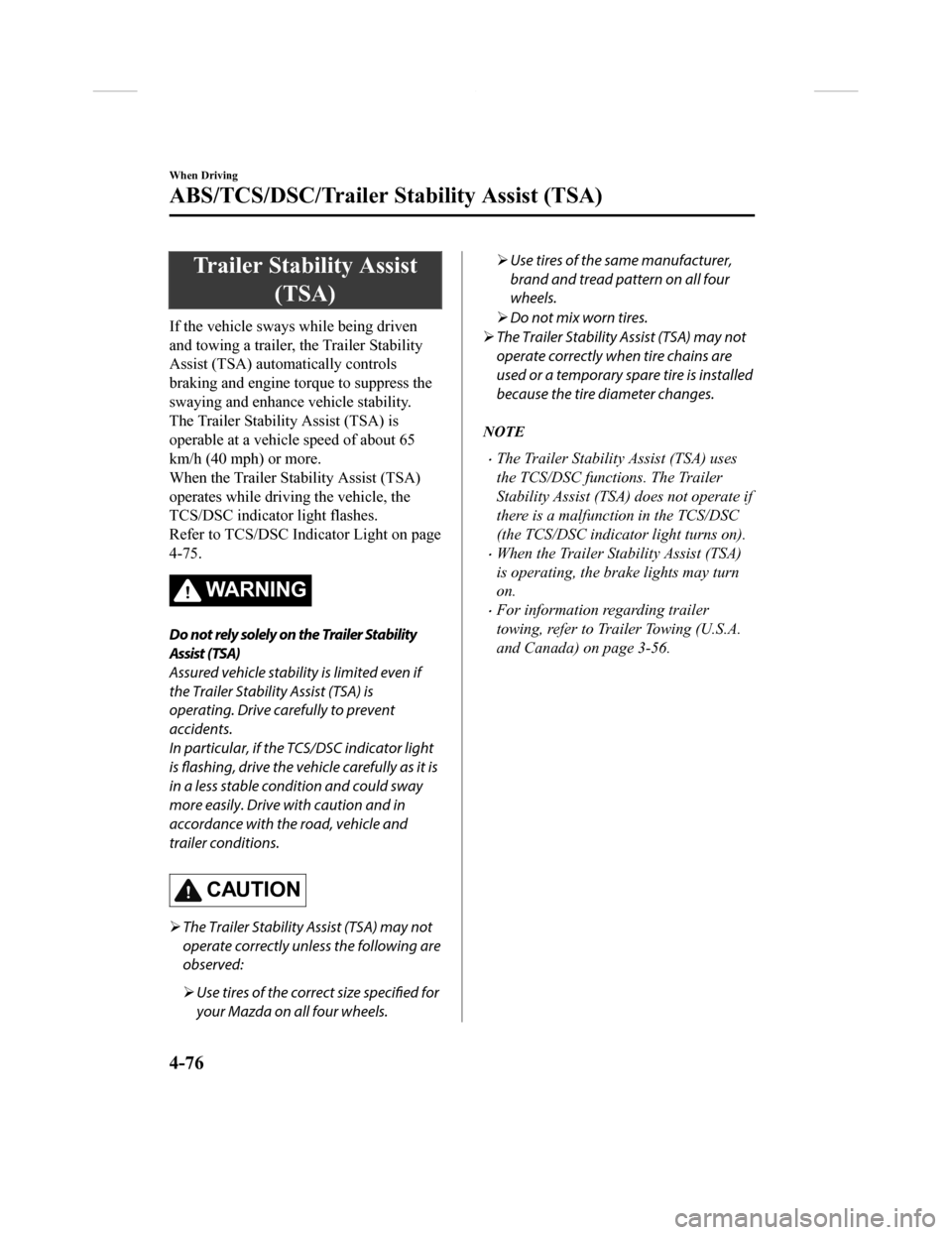MAZDA MODEL CX-9 2018 Owners Manual (in English)
Manufacturer: MAZDA, Model Year: 2018, Model line: MODEL CX-9, Model: MAZDA MODEL CX-9 2018Pages: 640
Page 221 of 640

Wear shoes appropriate for driving in
order to avoid your shoe contacting the
brake pedal when depressing the
accelerator pedal.
▼ Electric Parking Brake (EPB)
The EPB equipment applies the parking
brake using an electric motor. When the
EPB is applied, the EPB switch indicator
light turns on.
Indicator light
WA R N I N G
Do not drive the vehicle with the EPB
applied:
If the vehicle is driven with the parking
brake applied, the brake parts may
generate heat and the brake system may
not operate, leading to an accident.
Before driving, release the EPB and verify
that the brake system warning light is
turned off.
NOTE
•The EPB cannot be applied or released
while the vehicle battery is dead.
•If the EPB is repeatedly applied and
released it may stop operating to
prevent overheating of the motor. If this
occurs, wait approx. 1 minute before
operating the EPB switch again.
•An operation sound occurs when
applying or releasing the EPB, however,
this does not indicate a malfunction.
•If the EPB is not used for long periods,
an automatic inspection of the system is
performed while the vehicle is parked.
An operation sound can be heard,
however, this does not indicate a
problem.
•When the EPB is applied and the
ignition is switched OFF, an operation
sound can be heard, however, this does
not indicate a problem.
•The brake pedal may move while the
EPB is being applied or released,
however, this does not indicate a
problem.
•If the EPB switch is continually pulled
while driving the vehicle, the EPB will
be applied and the EPB warning beep
will be activated. When the switch is
released, the EPB is released and the
beep stops.
•If the EPB is applied with the ignition
switched off or in ACC, the brake system
warning light in the
instrument cluster
and the indicator light in the switch may
turn on for 15 seconds.
When Driving
Brake
4-67
CX-9_8GC3-EA-17G_Edition1 2017-5-29 10:13:38
Page 222 of 640

•When running the vehicle through an
automatic car wash, it may be necessary
to switch the ignition off with the
parking brake released depending on
the type of automatic car wash.
When applying the EPB
The EPB can be applied regardless of the
ignition switch position.
Securely depress the brake pedal and pull
up the EPB switch.
The EPB is applied and the brake system
warning light and the EPB switch
indicator light turn on.
Refer to Warning/Indicator Lights on page
4-31.
When releasing the EPB
The EPB can be released while the
ignition is switched ON or the engine is
running. When the EPB is released, the
brake system warning light and the EPB
switch indicator light turn off.
EPB manual release
Firmly depress the brake pedal and press
the EPB switch.
If the EPB switch is pressed without
depressing the brake pedal, the display or
indicator light in the instrument cluster
notifies the driver that the brake is not
depressed.
(Type A instrument cluster)
A message is displayed on the
multi-information display in the
instrument cluster.
Refer to Message Indicated in
Multi-information Display on page 7-46.
(Type B instrument cluster)
The brake pedal operation demand
indicator light in the instrument cluster
turns on.
When Driving
Brake
4-68
CX-9_8GC3-EA-17G_Edition1 2017-5-29 10:13:38
Page 223 of 640

EPB automatic release
If the accelerator pedal is depressed with
the EPB applied and all of the following
conditions met, the parking brake is
released automatically.
•The engine is running.
•The driver's door is closed.
•The driver's seat belt is fastened.
•Selector lever is in the D, M, or R
position
NOTE
If something such as the driver's foot
contacts the accelerator pedal with the
engine running and the EPB applied, the
parking brake may be released
automatically. If you do not intend to drive
immediately, shift the selector lever to the
P or N position.
▼ Warning Light
The warning light turns on when the
system has a malfunction.
Refer to Warning Indication/Warning
Lights on page 4-32.
▼Brake Pad Wear Indicator
When the disc brake pads become worn,
the built-in wear indicators contact the
disc plates. This caus
es a screeching noise
to warn that the pads should be replaced.
When you hear this noise, consult an
Authorized Mazda Dealer as soon as
possible.
WA R N I N G
Do not drive with worn disc pads:
Driving with worn disc pads is dangerous.
The brakes could fail and cause a serious
accident. As soon as you hear a screeching
noise consult an Authorized Mazda Dealer.
▼ Brake Assist
During emergency braking situations
when it is necessary to depress the brake
pedal with greater force, the brake assist
system provides braking assistance, thus
enhancing braking performance.
When the brake pedal is depressed hard or
depressed more quickly, the brakes apply
more firmly.
When Driving
Brake
4-69
CX-9_8GC3-EA-17G_Edition1
2017-5-29 10:13:38
Page 224 of 640

NOTE
•When the brake pedal is depressed hard
or depressed more quickly, the pedal
will feel softer but the brakes will apply
more firmly. This is a normal effect of
the brake assist operation and does not
indicate a malfunction.
•When the brake pedal is depressed hard
or depressed more quickly, a motor/
pump operation noise may be heard.
This is a normal effect of the brake
assist and does not indicate a
malfunction.
•The brake assist equipment does not
supersede the functionality of the
vehicle's main braking system.
Hill Launch Assist (HLA)
HLAis a function which assists the driver
in accelerating from a stop while on a
slope. When the driver releases the brake
pedal and depresses the accelerator pedal
while on a slope, the function prevents the
vehicle from rolling. The braking force is
maintained automatically after the brake
pedal is released on a steep grade.
HLAoperates on a downward slope when
the selector lever i s in the reverse (R)
position, and on an upward slope when the
selector lever is in a forward gear.
WA R N I N G
Do not rely completely on HLA:
HLA is an auxiliary device for accelerating
from a stop on a slope. The system only
operates for about two seconds and
therefore, relying only on the system, when
accelerating from a stop is dangerous
because the vehicle may move (roll)
unexpectedly and cause an accident.
The vehicle could roll depending on the
vehicle's load or if it is towing something.
Always confirm the safety around the
vehicle before starting to drive the vehicle.
NOTE
•HLA does not operate on a gentle slope.
In addition, the gradient of the slope on
which the system will operate changes
depending on the vehicle's load.
•HLA does not operate if the parking
brake is applied, or if the vehicle has not
stopped completely.
•HLA is operating, the brake pedal may
feel stiff and vibrate, however, this does
not indicate a malfunction.
When Driving
Brake
4-70
CX-9_8GC3-EA-17G_Edition1 2017-5-29 10:13:38
Page 225 of 640

•HLA does not operate while the
TCS/DSC indicator light is illuminated.
Refer to Warning/Indicator Lights on
page 4-31.
•HLA does not turn off even if the TCS
OFF switch is pressed to turn off the
TCS.
When Driving
Brake
4-71
CX-9_8GC3-EA-17G_Edition1 2017-5-29 10:13:38
Page 226 of 640

Antilock Brake System(ABS)
The ABS control unit continuously
monitors the speed o f each wheel. If one
wheel is about to lock up, the ABS
responds by automatically releasing and
reapplying that wheel's brake.
The driver will feel a slight vibration in
the brake pedal and may hear a chattering
noise from the brake system. This is
normal ABS system operation. Continue
to depress the brak e pedal without
pumping the brakes.
The warning light turns on when the
system has a malfunction.
Refer to Warning Indication/Warning
Lights on page 4-32.
WA R N I N G
Do not rely on ABS as a substitute for safe
driving:
The ABS cannot compensate for unsafe
and reckless driving, excessive speed,
tailgating (following another vehicle too
closely), driving on ice and snow, and
hydroplaning (reduced tire friction and
road contact because of water on the road
surface). You can still have an accident.
NOTE
•Braking distances may be longer on
loose surfaces (snow or gravel, for
example) which usually have a hard
foundation. A vehicle with a normal
braking system may require less
distance to stop under these conditions
because the tires wi ll build up a wedge
of surface layer when the wheels skid.
•The sound of the ABS operating may be
heard when starting the engine or
immediately after starting the vehicle,
however, it does not indicate a
malfunction.
When Driving
ABS/TCS/DSC/Trailer St ability Assist (TSA)
4-72
CX-9_8GC3-EA-17G_Edition1 2017-5-29 10:13:38
Page 227 of 640

Traction Control System(TCS)
The Traction Control System (TCS)
enhances traction and safety by controlling
engine torque and braking. When the TCS
detects driving wheel slippage, it lowers
engine torque and operates the brakes to
prevent loss of traction.
This means that on a slick surface, the
engine adjusts automatically to provide
optimum power to the drive wheels,
limiting wheel spin and loss of traction.
The warning light turns on when the
system has a malfunction.
Refer to Warning Indication/Warning
Lights on page 4-32.
WA R N I N G
Do not rely on the Traction Control System
(TCS) as a substitute for safe driving:
The Traction Control System (TCS) cannot
compensate for unsafe and reckless
driving, excessive speed, tailgating
(following another vehicle too closely), and
hydroplaning (reduced tire friction and
road contact because of water on the road
surface). You can still have an accident.
Use snow tires or tire chains and drive at
reduced speeds when roads are covered
with ice and/or snow:
Driving without proper traction devices on
snow and/or ice-covered roads is
dangerous. The Traction Control System
(TCS) alone cannot provide adequate
traction and you co uld still have an
accident.
NOTE
To turn off the TCS, press the TCS OFF
switch (page 4-74).
▼ TCS/DSC Indicator Light
This indicator light stays on for a few
seconds when the ignition is switched ON.
If the TCS, DSC or the Trailer Stability
Assist (TSA)
* is operating, the indicator
light flashes.
If the light stays on, the TCS, DSC or the
brake assist system may have a
malfunction and they may not operate
correctly. Take your vehicle to an
Authorized Mazda Dealer.
NOTE
•In addition to the indicator light
flashing, a slight lugging sound will
come from the engine. This indicates
that the TCS/DSC is operating properly.
•On slippery surfaces, such as fresh
snow, it will be impossible to achieve
high rpm when the TCS is on.
When Driving
ABS/TCS/DSC/Trailer Stability Assist (TSA)
*Some models.4-73
CX-9_8GC3-EA-17G_Edition1 2017-5-29 10:13:38
Page 228 of 640

▼TCS OFF Indicator Light
This indicator light
stays on for a few
seconds when the ignition is switched ON.
It also illuminates when the TCS OFF
switch is pressed and TCS is switched off.
Refer to TCS OFF Switch on page 4-74.
If the light remains illuminated and the
TCS is not switched off, take your vehicle
to an Authorized Mazda Dealer. The DSC
may have a malfunction.
▼ TCS OFF Switch
Press the TCS OFF sw
itch to turn off the
TCS. The TCS OFF indicator light in the
instrument cluster and TCS OFF switch
indicator light turn on.
Indicator light
Press the switch agai n to turn the TCS
back on. The TCS OFF indicator light and
TCS OFF switch indica tor light will turn
off.
NOTE
•When TCS is on and you attempt to free
the vehicle when it is stuck, or drive it
out of freshly fallen snow, the TCS (part
of the DSC system) will activate.
Depressing the accelerator will not
increase engine power and freeing the
vehicle may be difficult. When this
happens, turn off the TCS.
•If the TCS is off when the engine is
turned off, it aut omatically activates
when the ignition is switched ON.
•Leaving the TCS on will provide the best
traction.
•If the TCS OFF switch is pressed and
held for 10 seconds or longer, the TCS
can no longer be turned off even if the
TCS OFF switch is pressed.
In this case, the TCS OFF switch will
operate normally when the ignition is
switched ON again after being switched
OFF.
When Driving
ABS/TCS/DSC/Trailer St ability Assist (TSA)
4-74
CX-9_8GC3-EA-17G_Edition1 2017-5-29 10:13:38
Page 229 of 640

Dynamic Stability Control(DSC)
The Dynamic Stability Control (DSC)
automatically controls braking and engine
torque in conjunction with systems such as
ABS and TCS to help control side slip
when driving on slippery surfaces, or
during sudden or evasive maneuvering,
enhancing vehicle safety.
Refer to ABS (page 4 -72) and TCS (page
4-73).
DSC operation is possible at speeds
greater than 20 km/h (12 mph).
The warning light turns on when the
system has a malfunction.
Refer to Warning Indication/Warning
Lights on page 4-32.
WA R N I N G
Do not rely on the Dynamic Stability
Control as a substitute for safe driving:
The Dynamic Stability Control (DSC)
cannot compensate for unsafe and reckless
driving, excessive speed, tailgating
(following another vehicle too closely), and
hydroplaning (reduced tire friction and
road contact because of water on the road
surface). You can still have an accident.
CAUTION
The DSC may not operate correctly
unless the following are observed:
Use tires of the correct size
specified for
your Mazda on all four wheels.
Use tires of the same manufacturer,
brand and tread pattern on all four
wheels.
Do not mix worn tires.
The DSC may not operate correctly when
tire chains are used or a temporary spare
tire is installed because the tire diameter
changes.
▼ TCS/DSC Indicator Light
This indicator light stays on for a few
seconds when the ignition is switched ON.
If the TCS, DSC or the Trailer Stability
Assist (TSA)
* is operating, the indicator
light flashes.
If the light stays on, the TCS, DSC or the
brake assist system may have a
malfunction and they may not operate
correctly. Take your vehicle to an
Authorized Mazda Dealer.
When Driving
ABS/TCS/DSC/Trailer Stability Assist (TSA)
*Some models.4-75
CX-9_8GC3-EA-17G_Edition1 2017-5-29 10:13:38
Page 230 of 640

Trailer Stability Assist(TSA)
If the vehicle sways while being driven
and towing a trailer, the Trailer Stability
Assist (TSA) automatically controls
braking and engine torque to suppress the
swaying and enhance vehicle stability.
The Trailer Stability Assist (TSA) is
operable at a vehicle speed of about 65
km/h (40 mph) or more.
When the Trailer Stability Assist (TSA)
operates while driving the vehicle, the
TCS/DSC indicator light flashes.
Refer to TCS/DSC Indicator Light on page
4-75.
WA R N I N G
Do not rely solely on the Trailer Stability
Assist (TSA)
Assured vehicle stability is limited even if
the Trailer Stability Assist (TSA) is
operating. Drive carefully to prevent
accidents.
In particular, if the TCS/DSC indicator light
is flashing, drive the vehicle carefully as it is
in a less stable condition and could sway
more easily. Drive with caution and in
accordance with the road, vehicle and
trailer conditions.
CAUTION
The Trailer Stability Assist (TSA) may not
operate correctly unless the following are
observed:
Use tires of the correct size specified for
your Mazda on all four wheels.
Use tires of the same manufacturer,
brand and tread pattern on all four
wheels.
Do not mix worn tires.
The Trailer Stability Assist (TSA) may not
operate correctly when tire chains are
used or a temporary spare tire is installed
because the tire diameter changes.
NOTE
•The Trailer Stability Assist (TSA) uses
the TCS/DSC functions. The Trailer
Stability Assist (TSA) does not operate if
there is a malfunction in the TCS/DSC
(the TCS/DSC indicator light turns on).
•When the Trailer Stability Assist (TSA)
is operating, the brake lights may turn
on.
•For information regarding trailer
towing, refer to Trailer Towing (U.S.A.
and Canada) on page 3-56.
When Driving
ABS/TCS/DSC/Trailer St ability Assist (TSA)
4-76
CX-9_8GC3-EA-17G_Edition1 2017-5-29 10:13:38